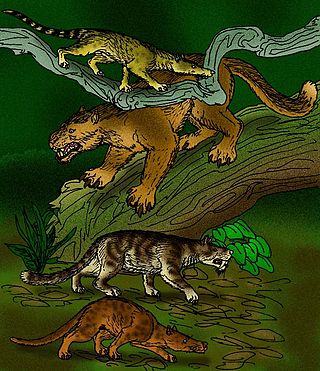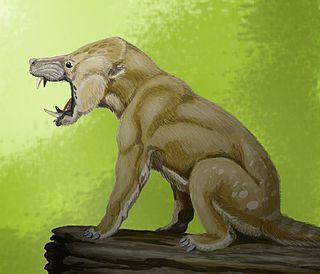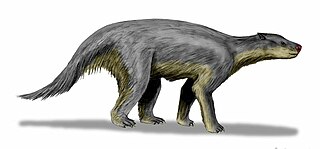
Leptictidium is an extinct genus of small mammals that were likely bipedal. Comprising eight species, they resembled today's bilbies, bandicoots, and elephant shrews, and occupied a similar niche. They are especially interesting for their combination of characteristics typical of primitive eutherians with highly specialized adaptations, such as powerful hind legs and a long tail which aided in locomotion. They were omnivorous, their diet a combination of insects, lizards, frogs, and small mammals. Leptictidium and other leptictids are not placentals, but are non-placental eutherians, although they are closely related to placental eutherians. They appeared in the Lower Eocene, a time of warm temperatures and high humidity, roughly fifty million years ago. Although they were widespread throughout Europe, they became extinct around thirty-five million years ago with no descendants, as they were adapted to live in forest ecosystems and were unable to adapt to the open plains of the Oligocene.

Creodonta is a former order of extinct carnivorous placental mammals that lived from the early Paleocene to the late Miocene epochs in North America, Europe, Asia and Africa. Originally thought to be a single group of animals ancestral to the modern Carnivora, this order is now usually considered a polyphyletic assemblage of two different groups, the oxyaenids and the hyaenodonts, not a natural group. Oxyaenids are first known from the Palaeocene of North America, while hyaenodonts hail from the Palaeocene of Africa.

Condylarthra is an informal group – previously considered an order – of extinct placental mammals, known primarily from the Paleocene and Eocene epochs. They are considered early, primitive ungulates. It is now largely considered to be a wastebasket taxon, having served as a dumping ground for classifying ungulates which had not been clearly established as part of either Perissodactyla or Artiodactyla, being composed thus of several unrelated lineages.

Mesonychia is an extinct taxon of small- to large-sized carnivorous ungulates related to artiodactyls. Mesonychians first appeared in the early Paleocene, went into a sharp decline at the end of the Eocene, and died out entirely when the last genus, Mongolestes, became extinct in the early Oligocene. In Asia, the record of their history suggests they grew gradually larger and more predatory over time, then shifted to scavenging and bone-crushing lifestyles before the group became extinct.

Chriacus is an extinct genus of placental mammals that lived in what is now North America during the Paleocene epoch and died out after the early Eocene. In life, members of the genus would have looked something like a kinkajou or binturong, though they were not closely related to any living mammal. Well preserved fossils allow clear information on what they looked like. They were about 1 metre (3.3 ft) long including a long, robust tail, which may or may not have been prehensile. Other features include a light build, weighing approximately 7 kg (15 lb), and many adaptations typical of animals that live in trees. These include walking on the soles of their five-toed feet, and having long, curved, compressed claws. The powerfully built limbs had flexible joints, especially the ankles, an adaptation that allows an animal to turn its hind feet behind it, like modern tree squirrels, in order to climb downward. They were probably omnivores, eating fruit, eggs, insects and small mammals.

Pyrotherium is an extinct genus of South American ungulate in the order Pyrotheria, that lived in what is now Argentina and Bolivia during the Late Oligocene. It was named Pyrotherium because the first specimens were excavated from an ancient volcanic ash deposit. Fossils of the genus have been found in the Deseado and Sarmiento Formations of Argentina and the Salla Formation of Bolivia.

Barylambda is an extinct genus of pantodont mammal from the middle to late Paleocene, well known from several finds in the Wasatchian DeBeque Formation of Colorado and the Clarkforkian Wasatch Formation to Tiffanian Fort Union Formation in Wyoming. Three species of Barylambda are currently recognized. The creature likely lived a life similar to that of a modern tapir, browsing on foliage and soft vegetation. Barylambda seems to have been quite successful for an early pantodont, though eventually it seems to have been replaced in its ecosystem by other pantodonts, such as Coryphodon.

Pantodonta is an extinct suborder of eutherian mammals. These herbivorous mammals were one of the first groups of large mammals to evolve after the end of the Cretaceous. The last pantodonts died out at the end of the Eocene.

Pachyaena was a genus of heavily built, relatively short-legged mesonychids, early Cenozoic mammals that evolved before the origin of either modern hoofed animals or carnivores, and combined characteristics similar to both. The genus likely originated from Asia and spread to Europe, and from there to North America across a land bridge in what is now the North Atlantic ocean. Various described species of Pachyaena ranged in size from a coyote to a bear. However, recent work indicates that Pachyaena is paraphyletic, with P. ossifraga being closer to Synoplotherium, Harpagolestes and Mesonyx than to P. gigantea.

Arctocyonidae is as an extinct family of unspecialized, primitive mammals with more than 20 genera. Animals assigned to this family were most abundant during the Paleocene, but extant from the late Cretaceous to the early Eocene . Like most early mammals, their actual relationships are very difficult to resolve. No Paleocene fossil has been unambiguously assigned to any living order of placental mammals, and many genera resemble each other: generalized robust, not very agile animals with long tails and all-purpose chewing teeth, living in warm closed-canopy forests with many niches left vacant by the K-T extinction.

Didymictis is an extinct genus of placental mammals from extinct subfamily Didymictinae within extinct family Viverravidae, that lived in North America and Europe from the late Paleocene to middle Eocene.

Tillodontia is an extinct suborder of eutherian mammals known from the Early Paleocene to Late Eocene of China, the Late Paleocene to Middle Eocene of North America where they display their maximum species diversity, the Middle Eocene of Pakistan, and the Early Eocene of Europe. Leaving no descendants, they are most closely related to the pantodonts, another extinct group. The tillodonts were medium- to large-sized animals that probably fed on roots and tubers in temperate to subtropical habitats.

Phenacodontidae is an extinct family of large herbivorous mammals traditionally placed in the “wastebasket taxon” Condylarthra, which may instead represent early-stage perissodactyls. They lived from the late early Paleocene to early middle Eocene and their fossil remains have been found in North America and Europe. The only unequivocal Asian phenacodontid is Lophocion asiaticus.

Triisodon is a genus of extinct mesonychian mammal that existed during the Early Paleocene of New Mexico, North America, from about 63.5-62.0 Ma. The genus was named by Edward Drinker Cope in 1881 as a member of the Acreodi, a now invalid taxon that encompassed creodonts, mesonychians and certain arctocyonians. Cope described the type specimen of T. quivirensis as "about the size of a wolf." A smaller species, T. crassicuspis, has also been identified from the same region. Since material from this genus is incomplete, the exact size of adults and whether they showed sexual dimorphism or regional variations in size is unknown.

Galecyon ("polecat-dog") is an extinct genus of placental mammals from extinct order Hyaenodonta, that lived in Europe and North America during the early Eocene.
Azygonyx was a small tillodont mammal, likely the size of a cat to raccoon, that lived in North America during the Paleocene and Eocene in the early part of the Cenozoic Era. The only fossils that have been recovered are from the Willwood and Fort Union Formations in the Bighorn Basin of Wyoming, United States, and date to the Clarkforkian to Wasatchian, about 56 to 50 million years ago. Fifty-six collections that have been recovered thus far include the remains of Azygonyx. Azygonyx survived the Paleocene Eocene Thermal Maximum along with other mammals like Phenacodus and Ectocion, both of which were ground-dwelling mammals. Azygonyx probably was a generalist terrestrial mammal that may have roamed around the ground, but was also capable of climbing trees.
Apatemys is a member of the family Apatemyidae, an extinct group of small and insectivorous placental mammals that lived in the Paleogene of North America, India, and Europe. While the number of genera and species is less agreed upon, it has been determined that two apatemyid genera, Apatemys and Sinclairella, existed sequentially during the Eocene in North America. The genus Apatemys, living as far back as 50.3 million years ago (mya), existed through part of the Wasatchian and persisted through the Duchesnean, and Sinclairella followed, existing from the Duchesnean through the Arikareean. Examinations of specimens belonging to the genus Apatemys suggest adaptations characteristic of arboreal mammals.
Navajovius is an extinct genus of plesiadapiforms that lived during the Paleocene epoch. Plesiadapiforms were small, arboreal mammals that are theorized to be either closely related to primates or dermopterans. Navajovius has only been documented from localities within North America. This genus was officially named in 1921 by Walter Granger and William Matthew and the type specimen is housed at the American Museum of Natural History.
Protolipterna is an extinct genus of mammal, belonging to the order Litopterna. It lived during the Late Paleocene and the Early Eocene, in what is now South America.

Periptychus is an extinct genus of mammal belonging to the family Periptychidae. It lived from the Early to Late Paleocene and its fossil remains have been found in North America.


















